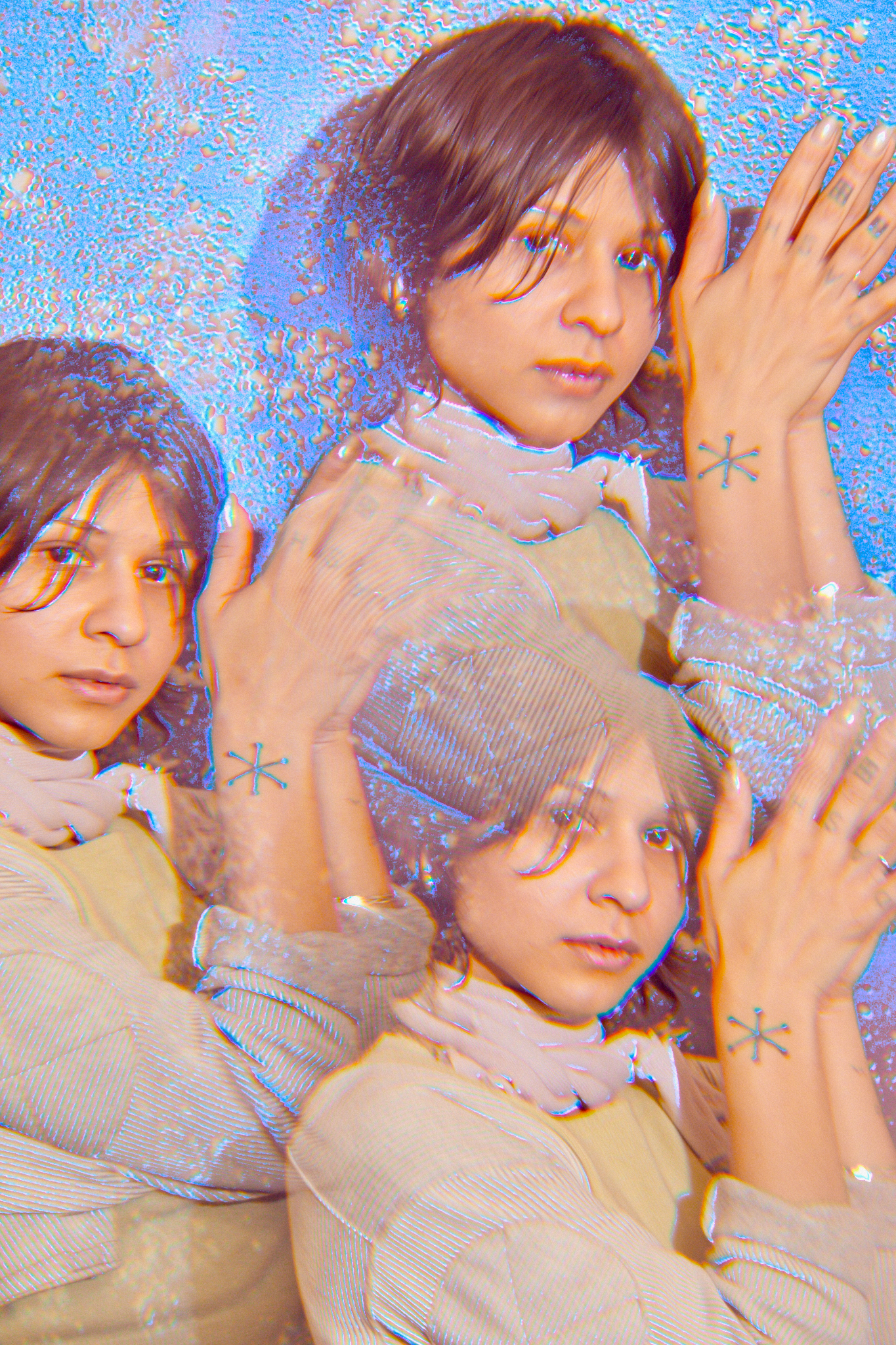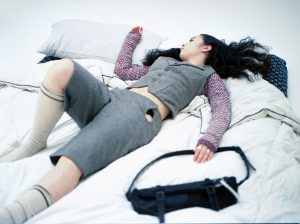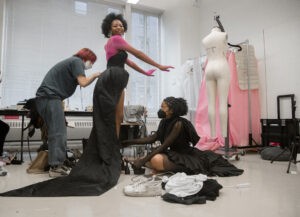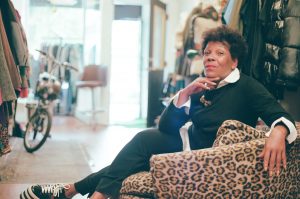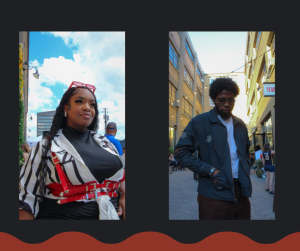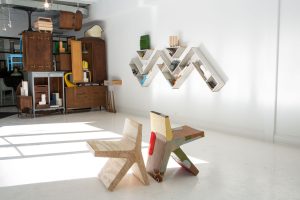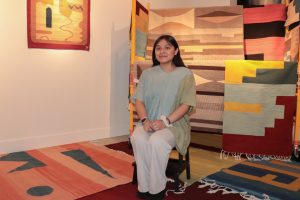FOLD/UNFOLD: fashion designers and artists on dress, tactics, community, and power in zhegagoynak/zhigaagoong (Chicago) and beyond.
Marissa Macias is an interdisciplinary artist and fashion designer from Chicago. She received her BFA at The Milwaukee Institute of Art and Design, where she developed her signature practice of designing fashion collections based upon highly fleshed-out narrative storytelling. I’m drawn to Macias’ effortless blend of rigorous tailoring, workwear influences, and touches of spooky-yet-playful melodrama. There’s something feral in her pieces, but you could still wear them to the club or to sneak into a squat and start working on the wiring. Dealer’s choice. We’ve previously discussed her highly collaborative process and the ways in which the clothes she designs imagine what a future beyond capitalism could look like as a garment. I see Macias as a highly theoretical designer who makes clothes to withstand the rigors of the physical work it will take to build the new worlds we want. Macias’ newest collection is forthcoming from her brand, Petrichor.
I recently sat down with her in her Humboldt Park studio to talk collection influences, vampires, Chicago aesthetics and work ethics, COVID and sensuality, toe rings, the future of kinkwear beyond leather harnesses, and other designers on her radar. Find Macias at petrich0r.com or @_petrich0r.us.
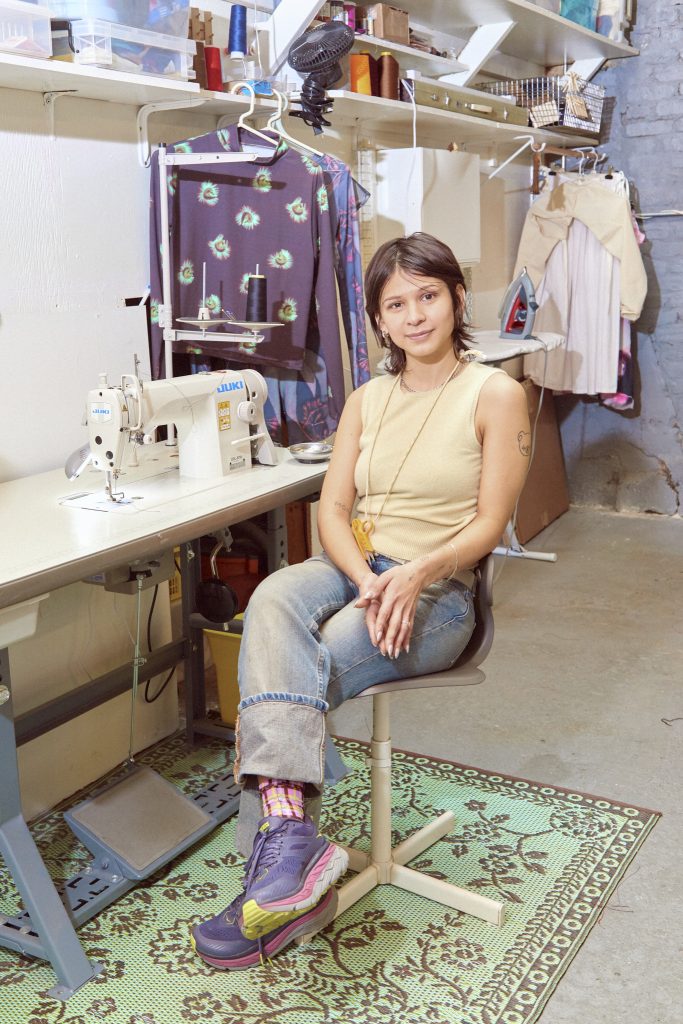
row särkelä: What’s alive for you today in terms of who you’re becoming as a designer?
Marissa Macias: The way that I navigate my life is very prevalent in everything that I’m making. I’m thinking a lot about bringing some element of fantasy to my designs by creating pieces that are multifunctional and have the potential to be worn casually, but also dressed up to the level of costume. I’m making a lot of stuff that I would consider to be activewear right now, but I approach it through the lens of dance and dance wear. I’m really inspired by ballet and gymnastics. Simple, stretchy pieces—but made to have some element of drama or melodrama. I’ve been getting a lot of inspiration from opera and ballet. That’s why the collection that I’m working on is called Odette, the main character of Swan Lake.
rs: Did you watch Swan Lake in preparation for this collection?
MM: I’ve seen it a couple times, but it really hit me when I watched the cartoon version of it with my niece. I was just like, “Wow, I fucking love this story.” It’s so messy. There’s a prince that doesn’t want to get married, but has to, and he’s like, “I’m not gonna get married, I’m gonna go play in the woods.” He finds a bunch of swans and one of them turns into a beautiful girl and then he falls in love with her. And he’s like, “I don’t want to marry a princess, I want to marry you!” And then a lot of drama happens [laughs]. There’s so many different endings to the ballet—sometimes they do end up together, or they don’t end up together, or they commit suicide together.
rs: Do you identify with one of the characters of Swan Lake?
MM: I wouldn’t say I identify with Odette, but I romanticize the idea of being able to change into an animal—especially now. When I had COVID, I had a tree in my window and there were always squirrels in it. I was like, “Damn, squirrels don’t have shit to worry about.” I don’t know, being a human right now is not looking like the best situation out of all of the possibilities of things to be [laughs]. I was thinking about that and watching Swan Lake. The overarching theme of the stuff that I’ve been making has been really inspired by these classic books about characters being really depressed and angsty in the woods. Frankenstein, Wuthering Heights, and Swan Lake are the big three on my mind right now. They’re all about being outcasted into nature and then being in nature, but being kinda goth and dark. Social outcasts. Then there’s this notion of survival. Camping stuff is trending right now, and activewear that’s super tactical, like North Face. When I look at that, I see that there’s always been an aspect of it that’s like rich-people hobbies, such as rock climbing and snowboarding and sports like that. But then there’s also the element of people doomsday prepping. I’m thinking about that and the post-apocalyptic element of it. Yeah, it’s a lot [laughs]. That’s what’s in my head.
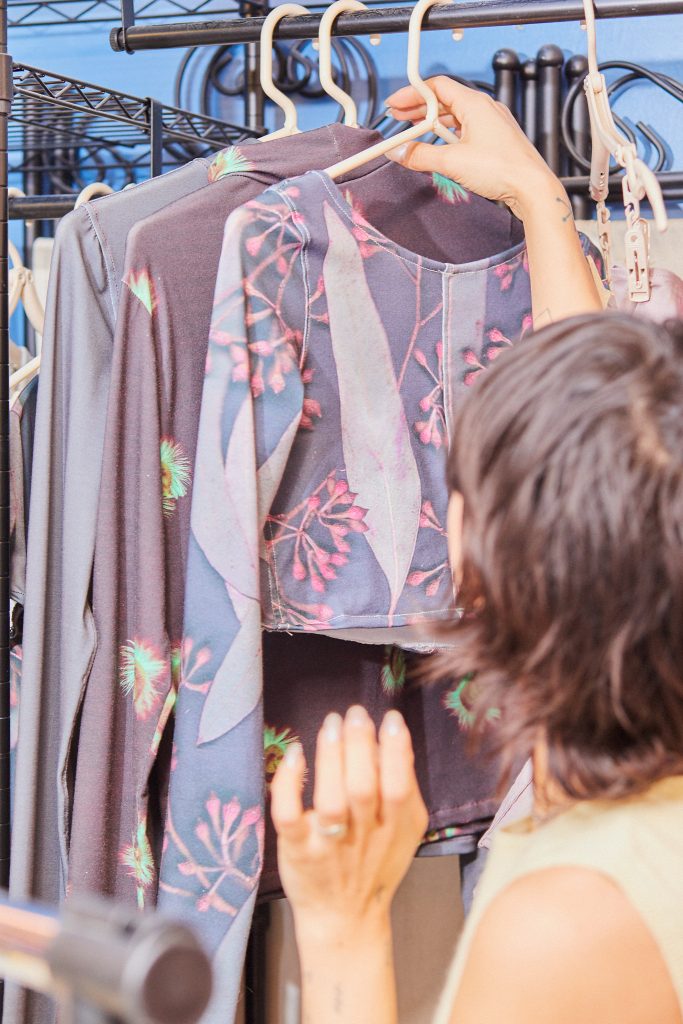
rs: How are you picturing the body and anatomy in this collection?
MM: I created this narrative [in my collection] of this spirit: it’s this woman [Cathy] who [has] died in the woods and is covered in foliage and haunting the forest, fused with the landscape and the forest floor. I’ve been working with flowers a lot lately, and when I’m working with them, I’m thinking about death. When I’m putting a flower on the scanner, it’s a dead thing. When I take it out of nature, it’s dead. When it’s on the forest floor, it’s dead, but it’s not inactively dead; it’s going back and being recycled. So this goes back to that character, Cathy, who I was thinking about when I was reading Frankenstein and Wuthering Heights. Two people fall in love, they can’t be together, and then one of them dies basically of being brokenhearted and confused. And she becomes a spirit. It’s like—drama [laughs]. Wuthering Heights is the property that this mansion is on that a really dysfunctional family lives at. And the landscape is super, super rugged, and it’s known for being super rugged. They’re seen as these uncivilized rich people because their surrounding landscape is out of control, feral. And they live in the moors, which is a place where a lot of people die.
rs: How do you address the themes of death and drama in your work?
MM: I’ve been thinking more about life and death. I don’t want my work to be overtly violent and dark. I want the pieces to feel haunting. But I don’t know how that carries through for other people. I guess I hope that they find it beautiful. I find it inspiring, not that I want to romanticize dying in the woods [laughs]. There’s a chance that something has died everywhere, and I’ve been thinking a lot about melodrama, too, lately. My life has been pretty mundane ever since COVID happened. It’s something I’m still grappling with because I’m not a very melodramatic person, but I find it exciting to think about that tension.
rs: I feel like you’re doing so much work in terms of storytelling. What do you think the relationship is between fashion/what we wear, narrative storytelling, and performance?
MM: I started out making clothes as costumes for performances. I had developed these alter egos, and [my friend and I] would do routines or host parties where I would build the costumes for [the performers]. I was in art school, but started to just focus on fashion, and my school didn’t have a fashion program. We had sewing machines—there was an industrial design program that basically funded most of the sewing stuff because they made backpacks. A lot of my teachers didn’t really know how to push me in the direction I’m at right now, but they did push me to really flesh out narratives about characters, which I liked doing a lot. I got into the habit of developing collections that way, about imagining a person or a character and a story of who they are, why they look like this, why they dress like this. So my first character was [a vampire] called Uno. I set it up like that first because I was into the idea of vampires [laughs], but also I like that vampire fashion has a lot of [influence] from different eras, and there’s clashing of different eras of fashion together in a playful way. At least that’s what Uno was about: me if I was alive for 300 years. Me if I was born on the day the sewing machine was invented, and the adventures and scenarios I would be in.
rs: I love the idea of 300 years of Uno.
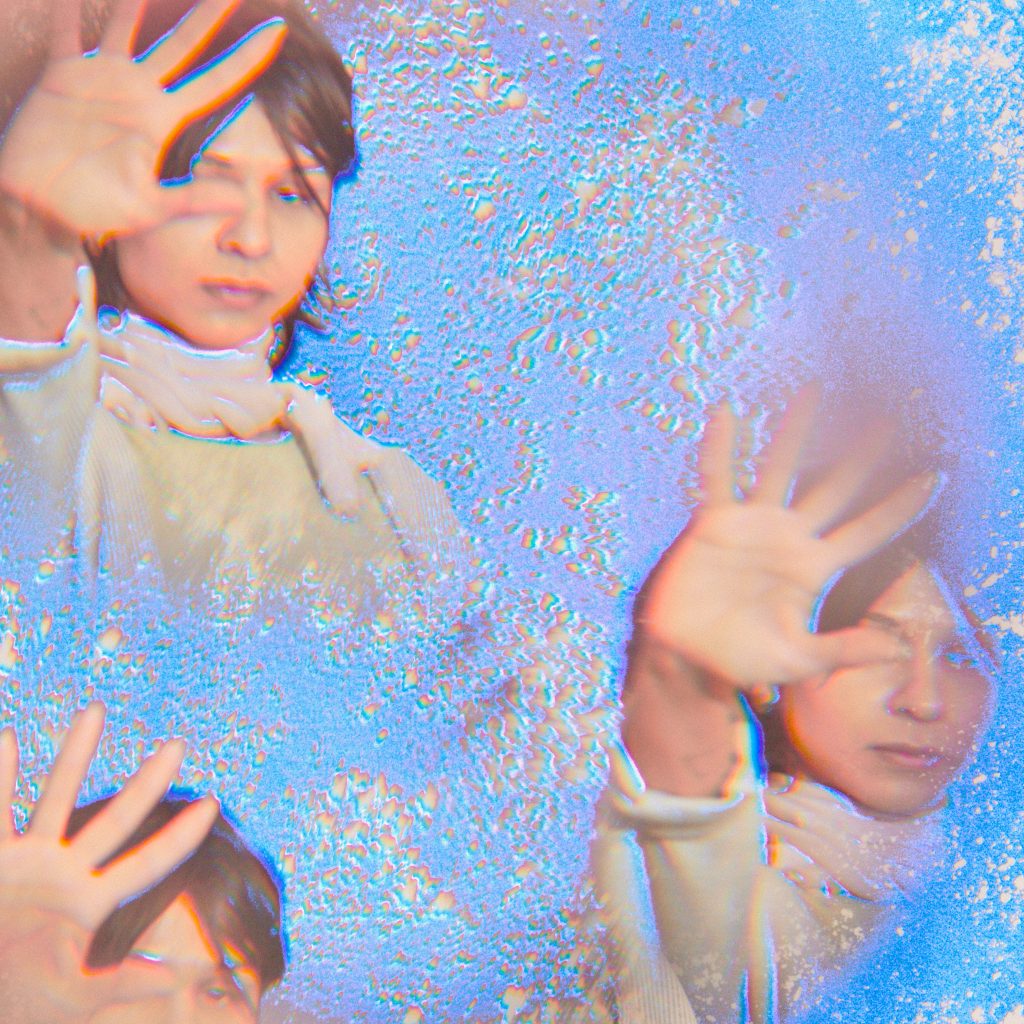
MM: Yeah, I imagine her to be nomadic and very on the run—living out of a backpack. So she’s got this tactical side —not a rich, aristocratic vampire, [but] a scrappy person who has to pick up and go a lot.
rs: Tactical as scrappy, as being ready to pick up and go. I think there’s something between being ready and preparing for the worst. Ready is about being dispersed and open to what might come up or emerge, and prepping is a singular idea of what the apocalypse is that has to be defended against.
MM: Right, like when the pandemic hit and everyone was buying food and buying toilet paper— that was the difference between being ready and preparing for the worst. It’s actually weird for me that I make clothes now, because I never thought of myself as a person who was into fashion because of my lifestyle. I was really into bikes when I was younger. I raced bikes, painted apartments, and did a lot of dirty work. I took a lot of pride in that, like “Yeah, I carry heavy shit all day and I love it and I use my body.” I always felt like I was too rugged to be a part of fashion, but I would still sew and alter my clothes and make them have weird pockets because I wanted to have pockets when I was biking and still look cool. I could never sacrifice fashion, you know? I could never go full sporty. I was always trying to make it slightly punk. I felt very anti fashion. That was before I learned about more subversive fashion like what I am doing now.
rs: How did you know what looked good? What built your aesthetic?
MM: I think it was the community of people I was engaging with, partly the bike community. There’s that layering. People would wear bike shorts under their shorts, or leggings under cutoff shorts–tuff like that. I was into it, but I would always dye it pink or put this cute anime patch on it. I was also into anime illustrations and ballet. Part of it was me wanting to look good still. I wanted to look cute. I wanted to have some sensual aspect to what I’m [was] wearing; I [didn’t] want to lose that completely. So I was always adjusting things and fitting them. Trying to get it just right.
rs: Do you feel like your ancestors show up in your work at all?
MM: I guess I would say fashion-wise, my ancestry has been coming into the picture more now, as I go back and look at old pictures of my mom’s family and my dad’s family in the 70s. My mom’s side is Italian and my dad’s side is Mexican. One thing I really appreciate about people back then is that they dressed all the time. So many people now will just wear sweatpants out to the store. But there’s all these memes about Italian grandpas and how you catch them doing yard work in dress shoes—they just always wear dress shoes. They always wear button-ups, no matter what. And I was looking at all these pictures of baptisms and weddings and just seeing all the suits. People just fucking had three-piece suits that had really cool colors, and it was just so fun. I’m looking at that a lot more now and thinking so much more about tailoring and construction and those classic pieces, and how they were subtly exaggerated. My dad’s side has more glam in it—well, both sides have glam. My dad’s mom went to beauty school and she was known to be super beautiful—like, kind of over the top. She’s still very glamorous. She wears blue eye contacts with huge blonde hair and a lot of toe rings. I’m not sure I would say I’m influenced by it, but I’m definitely, like, influenced by the effort. I’m influenced by the dedication, for sure.
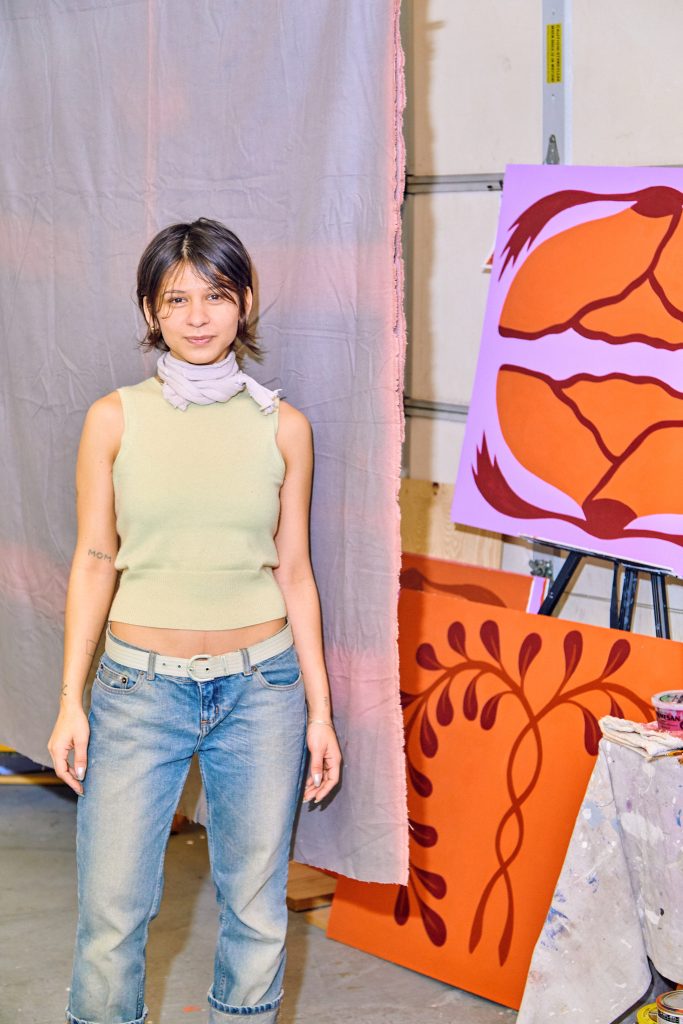
rs: Tell me about your workwear influence.
MM: I also worked with my dad, who was a janitor, for most of the time between being twelve and sixteen. We would paint apartments and shovel snow—he had a bunch of buildings he did that for. He was the maintenance guy. And I think that is what I’m mostly influenced by, having to transition from me being a young girl wanting to look and feel a certain way to that maintenance work, which I also really liked. I liked doing that work and I liked spending time with my dad and I took a weird amount of pride in being able to do it. I wanted my outfits to come together all the time. When I was going out, I still wanted to be myself and have my work clothes [on]. And my clothes that I brought in to work would get covered in paint. I liked it. Even now, I want my pieces to be versatile.
rs: How does being from the Great Lakes region impact your work?
MM: I was talking to my friend who moved to California, and he was like, “In Chicago, people fucking work really hard.” And it’s true! Seeing the work ethic of my parents definitely put in me a strong work ethic and I think that will always be in the stuff that I make. [In regards to the weather here,] I really want to make winter chaps because I don’t want to wear snow pants—but then I do want to wear snow pants [laughs]. I’ve been really trying to get my hands on a pair of Uggs lately, and I’m obsessed with wool pants. That’s a huge Chicago winter move—wool pants with fleece on the inside. I just do not like to compromise warmth. I can’t function.
rs: What are three words to describe your clothing brand, Petrichor’s, aesthetic, and three words you would use to describe a Chicago stylish cutie?
MM: Petrichor: utilitarian, sentimental, and play. Chicago stylish cutie: tactical, sensible shoes, and comfort.
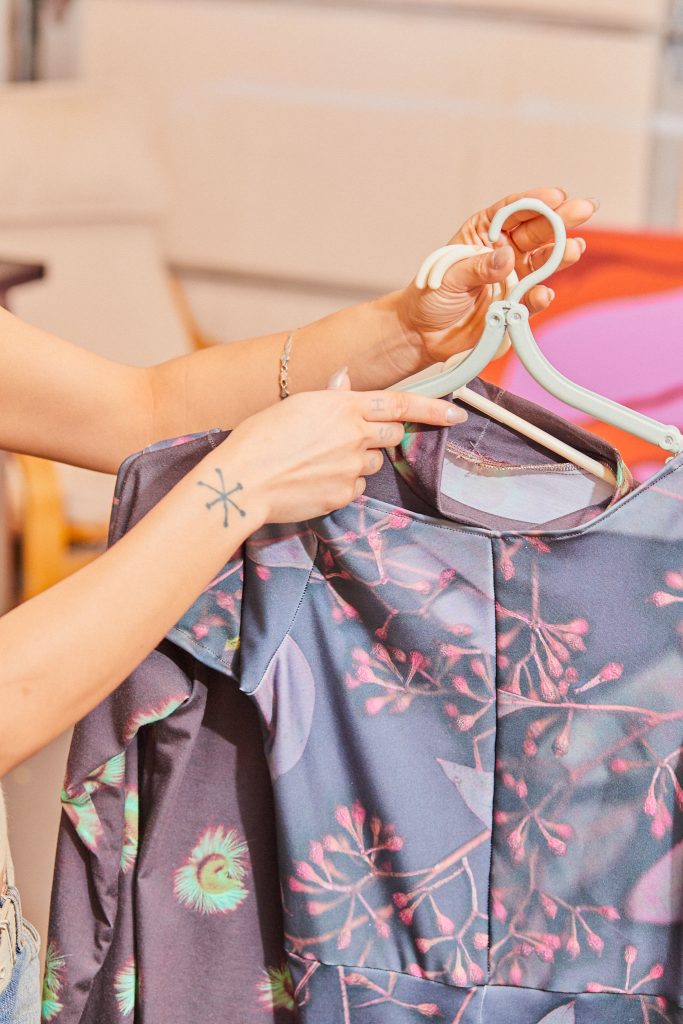
rs: What do you want to see in the Chicago fashion world?
MM: I want to see serious fashion writing. I’ve had the privilege of talking to other designers, and it’s just really exciting. There’s so many interviews and pieces of writing about art and I feel like it is disproportionate with what is written about fashion here. There’s no good fashion magazines. I hate ads, but I would love to see a fucking place where, in print, Chicago designers are being promoted outside of the insular world of the people that already know. [I would like to see] more participation from people who are not artists. I really like the boulevards [near the Logan Square Farmer’s Market] as a place where that happens. People bring their stuff there and there’s a nice exchange— sometimes it’s art, sometimes it’s thrifted, and you’re getting all the people that are just going to the farmers market, which is a bougie event. But I go there—I just like the flowers and organic produce and whatever.
rs: Who are three designers in Chicago that inspire you right now?
MM: Casper who runs Gutter, Alyx Harch who runs HARCH, [and] My studio mate, Olivia Rehm, who runs Renmei.
rs: Tell me about your current studio space, and what your ideal studio would look like.
MM: I moved a lot throughout Chicago, but I lived in this area of Humboldt Park and Ukrainian Village a lot. I’ve been in [my] studio [in Humboldt Park] for three years and we just agreed on Corner Studio as a name. It’s me, Olivia Ream, Lola Dement Myers, and Rory Pipia. I really admire my studio-mates.
My ideal studio would be something with heat [laughs] and something with a storefront. Not to have it be a store, but just to put stuff out there. I’d like it to be warm and inviting when people come in for fittings.
rs: How does sensuality and intimacy show up in your work right now, especially with COVID?
MM: Spending a lot of time alone has really made me think about sensuality differently. I ended this relationship and went into the alone zone for the first time in a long time. I think I used to project things onto situations, but when I’m alone I’m being present. I’m facing being present in my body. For the first time ever I watched the seasons change. Every week, I’d be like, “Good job, leaf.” [Laughs] I became more into things that were subtly sensual. My ideas about what is sexy and sensual have really taken a turn for the peaceful. You know what’s so hot? Breezes are so hot— you can feel it in all of your hair, especially if you’re hairy and you’re wearing a tank top. It swishes around, it feels really good. I like that! Let’s go outside. Outside is so hot! I want people to feel that when they wear my clothes, [they are] able to be very present in their body, because they feel good.
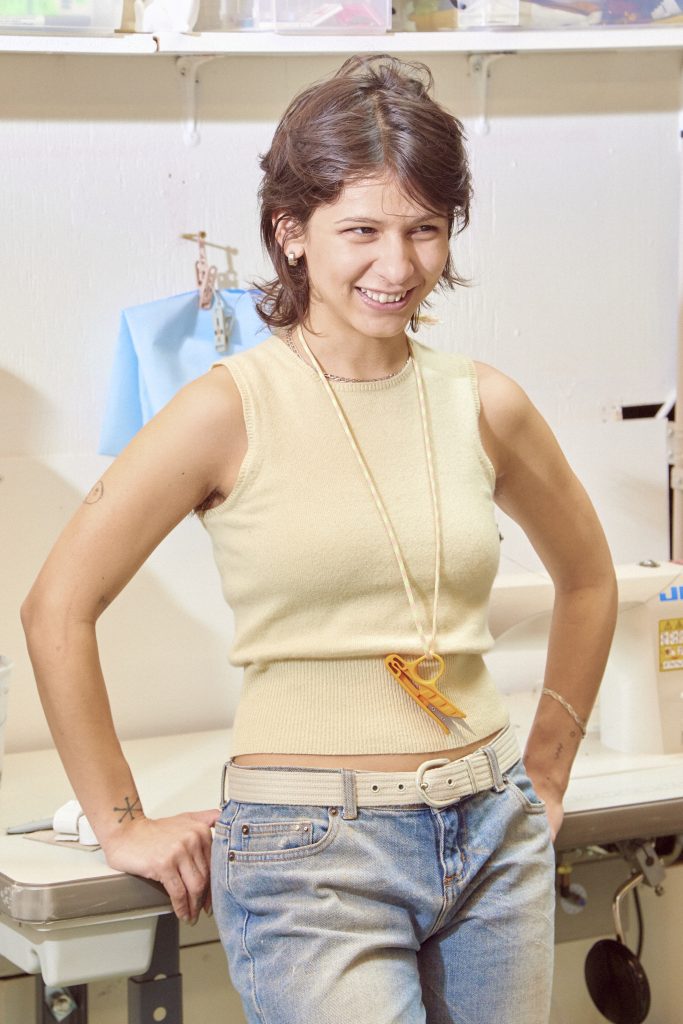
rs: Would you ever make a kinkwear collection?
MM: I’ve been freelancing for a while and I have a lot of weird jobs. I’ve been a dominatrix—which was another identity play for me—and developed an alter ego and a whole wardrobe for that. I don’t like patriarchal fetishwear. My alter ego doesn’t really fuck with leather too heavily. I would do a subversive suit or something that’s more like power play in a different way, or super sensual with a powerful edge to it. I used to be more passive about it, but as I experienced more things and experienced more violence, I realized that stereotypical fetishwear doesn’t fit in my world, [it] doesn’t really jive with who I am and what I believe in. I always thought it was funny that the dominatrix was supposed to wear a harness or restrictive clothes, when it was actually supposed to be the opposite, since that’s to [restrict] you… I always see that as the sub thing. I just can’t unsee it as a thing of power and it kinda kills it for me. So much of what we base power in is very tired. When I feel uncomfortable is when I’m being forced to flatten myself. People are so complicated. I’m a full person; I don’t want to just experience this one aspect of you.
I chose to be a dominatrix because it made me feel most safe. I wanted to be in control. I wanted someone I could [be] at a safe distance from myself. When I started, I was the worst dominatrix ever. But I feel like, for me, the being myself part has always been my selling point. I’m not good at being, like, hot. I can, but the stuff that I like is not untraditional, but is not something I was introduced to. “Instead of trying to be hot, I would make it a point to be really honest [with my clients], and that made an actual bond [between us]. They actually want to know you. They’re looking for creative people to feel inspired. To feel alive.
Featured image: Marissa Macias faces the camera with her hands together towards her head. Three images of Marissa are arranged like a kaleidoscope on a silvery-blue background. Photo by Sarah Joyce.
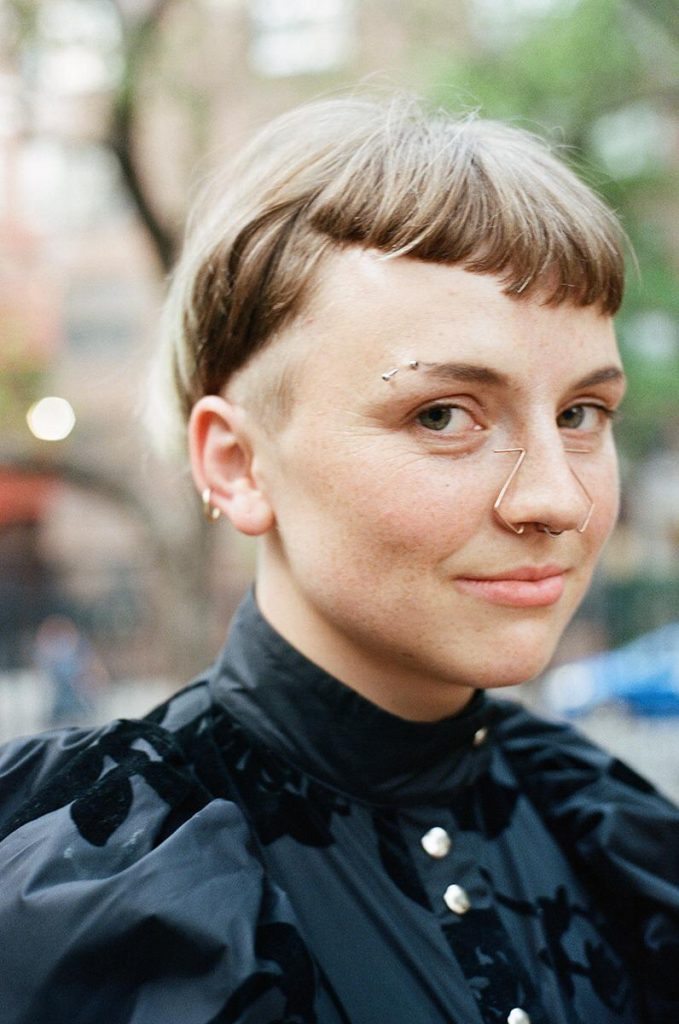
row särkelä is an organizer, artist, and white settler raised in tiwaland and living in zhigaagoong. in “fold unfold,” row addresses the seepages between fashion and social movement organizing, surfacing the work of designers and artists who shape and intervene in chicago’s vestiary landscapes. row considers taste to be a political project and investigates how design and dress unfold in relation to local forms of racial capitalism.
